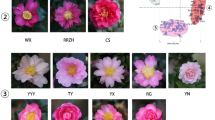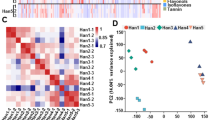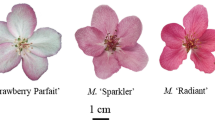Abstract
Anthocyanin biosynthesis is one of the best studied secondary metabolisms. However, related pathways were generally concluded based on anthocyanin components; most studies focused on the backbone forming of anthocyanidins (cyanidin, delphinidin, and pelargonidin) of model or commercial plants, while anthocyanin modification was less discussed, and non-model plants with abundant colorations were less researched either. Ranunculus asiaticus L. has great diversity in flower colorations, not only indicating its value in researching anthocyanin biosynthesis but also implying it is unique in this regard. Based on transcriptome sequencing and gene annotation of three varieties (10 samples) of Ranunculus asiaticus L., 176 unigenes from 151,136 unigenes were identified as involved in anthocyanin biosynthesis, among which, 74 unigenes were related to anthocyanin modification; 61 unigenes were responsible for glycosylation at C3 and C5 with 3-monosaccharides of glucose, 3-biosides of rutinose, sophorose, or sambubiose to form 3Gly-, 3Gly5Gly-, 3Gly3′Gly-, 3Gly2′′Gly-, 3Gly2′′Xly-, 3Gly2′′Rly-glycosylated anthocyanins, etc.; 2 unigenes transferred –CH3; 11 unigenes of BAHD family catalyzd the aromatic or malonyl acylation at 6′′ / 6′′′′position of 3/5-O-glucoside. Based on gene composition, a putative pathway was established. The pathway was validated by flower colorations, and gene expression patterns where F3H, F3′H, 3GT, 5GT, and FMT2 were highly expressed in varieties colored as lateritious and carmine, while variety with purple flowers had high expression of F3′5′H and 3MAT. In view of anthocyanin biosynthesis pathway of Ranunculus asiaticus L., great diversity in its flower colorations was illustrated via the complete branches (F3H, F3′H and F3′5′H) as well as complete modifications (glycosylation, methylation, and acylation), and besides, via the higher percentage of C3 glycosylation than C5 glycosylation.







Similar content being viewed by others
References
Ahmed NU, Park JI, Jung HJ, Yang TJ, Hur Y, Nou IS (2014) Characterization of dihydroflavonol 4-reductase (DFR) genes and their association with cold and freezing stress in Brassica rapa. Gene 550:46–55. https://doi.org/10.1016/j.gene.2014.08.013
Ali HM, Almagribi W, Al-Rashidi MN (2016) Antiradical and reductant activities of anthocyanidins and anthocyanins, structure-activity relationship and synthesis. Food Chem 194:1275–1282. https://doi.org/10.1016/j.foodchem.2015.09.003
Andersen CL, Jensen JL, Ørntoft TF (2004) Normalization of real-time quantitative reverse transcription-PCR data: a model-based variance estimation approach to identify genes suited for normalization, applied to bladder and colon cancer data sets. Cancer Res 64:5245–5250. https://doi.org/10.1158/0008-5472.CAN-04-0496
Azadi P, Bagheri H, Nalousi AM, Nazari F, Chandler SF (2016) Current status and biotechnological advances in genetic engineering of ornamental plants. Biotechnol Adv 34:1073–1090. https://doi.org/10.1016/j.biotechadv.2016.06.006
Bruyn FD, Maertens J, Beauprez J, Soetaert W, Mey MD (2015) Biotechnological advances in UDP-sugar based glycosylation of small molecules. Biotechnol Adv 33:288–302. https://doi.org/10.1016/j.biotechadv.2015.02.005
Chen L, Zhong HY, Kuang JF, Li JG, Lu WJ, Chen JY (2011) Validation of reference genes for RT-qPCR studies of gene expression in banana fruit under different experimental conditions. Planta 234:377–390. https://doi.org/10.1007/s00425-011-1410-3
Chen W, Su H, Xu Y, Bao T, Zheng X (2016) Protective effect of wild raspberry (Rubus hirsutus Thunb.) extract against acrylamide-induced oxidative damage is potentiated after simulated gastrointestinal digestion. Food Chem 196:943–952. https://doi.org/10.1016/j.foodchem.2015.10.024
Dhooghe E, Grunewald W, Reheul D, Goetghebeur P, Van Labeke MC (2012) Floral characteristics and gametophyte development of Anemone coronaria L. and Ranunculus asiaticus L. (Ranunculaceae). Sci Hortic 138:73–80. https://doi.org/10.1016/j.scienta.2011.10.004
Gowd V, Jia ZQ, Chen W (2017) Anthocyanins as promising molecules and dietary bioactive components against diabetes – a review of recent advances. Trends Food Sci Technol 68:1–13. https://doi.org/10.1016/j.tifs.2017.07.015
Grabherr MG, Haas BJ, Yassour M, Levin JZ, Thompson DA, Amit I, Adiconis X, Fan L, Raychowdhury R, Zeng QD, Chen ZH, Mauceli E, Hacohen N, Gnirke A, Rhind N, Palma FD, Birren BW, Nusbaum C, Lindblad-Toh K, Friedman N, Regev A (2011) Trinity: reconstructing a full-length transcriptome without a genome from RNA-Seq data. Nat Biotechnol 29:644–652. https://doi.org/10.1038/nbt.1883
Hellemans J, Mortier G, Paepe AD, Speleman F, Vandesompele J (2007) qBase relative quantification framework and software for management and automated analysis of real-time quantitative PCR data. Genome Biol 8:R19. https://doi.org/10.1186/gb-2007-8-2-r19
Hörandl E, Emadzade K (2012) Evolutionary classification: a case study on the diverse plant genus Ranunculus L. (Ranunculaceae). Perspect Plant Ecol 14:310–324. https://doi.org/10.1016/j.ppees.2012.04.001
Katsumoto Y, Fukuchi-Mizutani M, Fukui Y, Brugliera F, Holton TA, Karan M, Nakamura N, Yonekura-Sakakibara K, Togami J, Pigeaire A, Tao GQ, Nehra NS, Lu CY, Dyson BK, Tsuda S, Ashikari T, Kusumi T, Mason JG, Tanaka Y (2007) Engineering of the rose flavonoid biosynthetic pathway successfully generated blue-hued flowers accumulating delphinidin. Plant Cell Physiol 48:1589–1600. https://doi.org/10.1093/pcp/pcm131
Koyama K, Kamiqakiuchi H, Iwashita K, Mochioka R, Goto-Yamamoto N (2017) Polyphenolic diversity and characterization in the red-purple berries of East Asian wild Vitis species. Phytochemistry 134:78–86. https://doi.org/10.1016/j.phytochem.2016.10.003
Kuntz S, Kunz C, Rudloff S (2017) Inhibition of pancreatic cancer cell migration by plasma anthocyanins isolated from healthy volunteers receiving an anthocyanin-rich berry juice. Eur J Nutr 56(1):203–214. https://doi.org/10.1007/s00394-015-1070-3
Lee YM, Yoon Y, Yoon H, Park HM, Song S, Yeum KJ (2017) Dietary anthocyanins against obesity and inflammation. Nutrients 9(10):1089. https://doi.org/10.3390/nu9101089
Li Y, Bao T, Chen W (2018) Comparison of the protective effect of black and white mulberry against ethyl carbamate-induced cytotoxicity and oxidative damage. Food Chem 243:65–73. https://doi.org/10.1016/j.foodchem.2017.09.106
Liu YF, Zhang JH, Lü B, Yang XH, Li YG, Wang Y, Wang JM, Zhang H, Guan JJ (2013) Statistic analysis on quantitative characteristics for developing the DUS test guideline of Ranunculus asiaticus L. J Integr Agric 12:971–978. https://doi.org/10.1016/S2095-3119(13)60474-8
Lou Q, Liu YL, Qi YY, Jiao SZ, Tian FF, Jiang L, Wang YJ (2014) Transcriptome sequencing and metabolite analysis reveals the role of delphinidin metabolism in flower colour in grape hyacinth. J Exp Bot 65:3157–3164. https://doi.org/10.1093/jxb/eru168
Lu QN, Yang Q (2006) cDNA cloning and expression of anthocyanin biosynthetic genes in wild potato (Solanum pinnatisectum). Afr J Biotechnol 5:811–818. https://doi.org/10.4314/ajb.v5i10.42857
Morohashi K, Casas MI, Ferreyra MLF, Mejía-Guerra MK, Pourcel L, Yilmaz A, Feller A, Carvalho B, Emiliani J, Rodriguez E, Pellegrinet S, McMullen M, Casati P, Grotewold E (2012) A genome-wide regulatory framework identifies maize pericarp color1 controlled genes. Plant Cell 24:2745–2764. https://doi.org/10.1105/tpc.112.098004
Nakatsuka T, Nishihara M, Mishiba K, Yamamura S (2005) Temporal expression of flavonoid biosynthesis-related genes regulates flower pigmentation in gentian plants. Plant Sci 168:1309–1318. https://doi.org/10.1016/j.plantsci.2005.01.009
Nakatsuka A, Mizuta D, Kii Y, Miyajima I, Kobayashi N (2008) Isolation and expression analysis of flavonoid biosynthesis genes in evergreen azalea. Sci Hortic 118:314–320. https://doi.org/10.1016/j.scienta.2008.06.016
Noda N, Yoshioka S, Kishimoto S, Nakayama M, Douzono M, Tanaka Y, Aida R (2017) Generation of blue chrysanthemums by anthocyanin B-ring hydroxylation and glucosylation and its coloration mechanism. Sci Adv 3:e1602785. https://doi.org/10.1126/sciadv.1602785
Oertel A, Matros A, Hartmann A, Arapitsas P, Dehmer KJ, Marten S, Mock HP (2017) Metabolite profiling of red and blue potatoes revealed cultivar and tissue specific patterns for anthocyanins and other polyphenols. Planta 246:281–297. https://doi.org/10.1007/s00425-017-2718-4
Pfaffl MW (2001) A new mathematical model for relative quantification in real-time RT-PCR. Nucleic Acids Res 29:2002–2007
Povero G, Gonzali S, Bassolino L, Mazzucato A, Perata P (2011) Transcriptional analysis in high-anthocyanin tomatoes reveals synergistic effect of Aft and atv genes. J Plant Physiol 168:270–279. https://doi.org/10.1016/j.jplph.2010.07.022
Sasaki N, Nakayama T (2015) Achievements and perspectives in biochemistry concerning anthocyanin modification for blue flower coloration. Plant Cell Physiol 56:28–40. https://doi.org/10.1093/pcp/pcu097
Sasaki N, Matsuba Y, Abe Y, Okamura M, Momose M, Umemoto N, Nakayama M, Itoh Y, Ozeke Y (2013) Recent advances in understanding the anthocyanin modification steps in carnation flowers. Sci Hortic 163:37–45. https://doi.org/10.1016/j.scienta.2013.07.029
Sasaki N, Nishizaki Y, Ozeki Y, Miyahara T (2014) The role of acyl-glucose in anthocyanin modifications. Molecules 19:18747–18766. https://doi.org/10.3390/molecules191118747
Sun T, Xu YX, Zhang DL, Zhuang HF, Wu JQ, Sun GL (2016) An acyltransferase gene that putatively functions in anthocyanin modification was horizontally transferred from Fabaceae into the genus Cuscuta. Plant Divers 38:149–155. https://doi.org/10.1016/j.pld.2016.04.002
Tanaka Y, Ohmiya A (2008) Seeing is believing: engineering anthocyanin and carotenoid biosynthetic pathways. Curr Opin Biotechnol 19:190–197. https://doi.org/10.1016/j.copbio.2008.02.015
Tiwari P, Sangwan RS, Sangwan NS (2016) Plant secondary metabolism linked glycosyltransferases: an update on expanding knowledge and scopes. Biotechnol Adv 34:714–739. https://doi.org/10.1016/j.biotechadv.2016.03.006
Toki K, Takeuchi M, Saito N, Honda T (1996) Two malonylated anthocyanidin glycosides in Ranunculus asiaticus. Phytochemistry 42:1055–1057. https://doi.org/10.1016/0031-9422(96)00099-4
Wang ZW, Jiang C, Wen Q, Wang N, Tao YY, Xu LA (2014) Deep sequencing of the Camellia chekiangoleosa transcriptome revealed candidate genes for anthocyanin biosynthesis. Gene 538:1–7. https://doi.org/10.1016/j.gene.2014.01.035
Wu T, Yu Z, Tang Q, Song H, Gao Z, Chen W, Zheng X (2013) Honeysuckle anthocyanin supplementation prevents diet-induced obesity in C57BL/6 mice. Food Funct 4(11):1654–1661. https://doi.org/10.1039/c3fo60251f
Xie Y, Sun Y, Huang JR (2013) Anthocyanin modification in Arabidopsis. Plant Physiol J 49:101–110. https://doi.org/10.13592/j.cnki.ppj.2013.02.008 (in Chinese)
Xie LH, Su HM, Sun CD, Zheng XD, Chen W (2018) Recent advances in understanding the anti-obesity activity of anthocyanins and their biosynthesis in microorganisms. Trends Food Sci Technol 72:13–24. https://doi.org/10.1016/j.tifs.2017.12.002
Xiong S, Tian N, Long J, Chen Y, Qin Y, Feng J, Xiao W, Liu S (2016) Molecular cloning and characterization of a flavanone 3-hydroxylase gene from Artemisia annua L. Plant Physiol Biochem 105:29–36. https://doi.org/10.1016/j.plaphy.2016.04.005
Xue L, Wang ZG, Zhang W, Li YX, Wang J, Lei JJ (2016) Flower pigment inheritance and anthocyanin characterization of hybrids from pink-flowered and white-flowered strawberry. Sci Hortic 200:143–150. https://doi.org/10.1016/j.scienta.2016.01.020
Yan YY, Liu YM, Liu YM, Li L, Li JJ, Zhou WY (2018) Long-term banding modifies the changes to foliar coloration of Acer rubrum L. ‘Brandywine’. Sci Hortic 228:167–180. https://doi.org/10.1016/j.scienta.2017.09.035
Zha J, Koffas MAG (2017) Production of anthocyanins in metabolically engineered microorganisms: current status and perspectives. Synth Syst Biotechnol 2:259–266. https://doi.org/10.1016/j.synbio.2017.10.005
Zhang JH, Liu YF, Yang XH, Huang QM, Wang JM, Zhang P, Zhang H, Hou XW, Guan JJ (2014a) Guidelines for the conduct of tests for distinctness, uniformity and stability - persian buttercup (Ranunculus asiaticus L.) (NY/T 2579–2014). Chinese Agricultural Press, Beijing, pp 4–16 ISBN: 16109·3220
Zhang Y, Butelli E, Martin C (2014b) Engineering anthocyanin biosynthesis in plants. Curr Opin Plant Biol 19:81–90. https://doi.org/10.1016/j.pbi.2014.05.011
Zhang YH, Zhang SD, Ling LZ (2015) De novo transcriptome analysis to identify flavonoid biosynthesis genes in Stellera chamaejasme. Plant Gene 4:64–68. https://doi.org/10.1016/j.plgene.2015.09.006
Zhao CL, Yu YQ, Chen ZJ, Wen GS, Wei FG, Zheng Q, Wang CD, Xiao XL (2017) Stability-increasing effects of anthocyanin glycosyl acylation. Food Chem 214:119–128. https://doi.org/10.1016/j.foodchem.2016.07.073
Zhao ZG, Yan HF, Zheng R, Saeed KM, Fu X, Tao Z, Zhang ZY (2018) Anthocyanins characterization and antioxidant activities of sugarcane (Saccharum officinarum L.) rind extracts. Ind Crop Prod 113:38–45. https://doi.org/10.1016/j.indcrop.2018.01.015
Zhuang Y, Tripp EA (2017) The draft genome of Ruellia speciosa (beautiful wild petunia: acanthaceae). DNA Res 24:179–192. https://doi.org/10.1093/dnares/dsw054
Funding
This work was supported by grants from the National Natural Science Foundation of China (CN) (31760589), Natural Science Foundation of Yunnan Province (2015FB158), Joint Special Project of Yunnan Province for Agricultural Basic Research (2017FG01 (−032)), Personnel Training Project of Yunnan Province (2015HB100), and Protection of Plant Variety Resources of Ministry of Agriculture (1120162130135396009).
Author information
Authors and Affiliations
Contributions
Y.L. and H.T. conceived and designed the experiments; Y.L., J.Z., J.W., and Q.H. performed the experiments; Y.L., X.Y., and P.Z. analyzed the data; Y.L. and J.M. collected data; Y.L. and Q.H. wrote the paper.
Corresponding authors
Additional information
Responsible editor: Philippe Garrigues
Rights and permissions
About this article
Cite this article
Liu, Y., Zhang, J., Yang, X. et al. Diversity in flower colorations of Ranunculus asiaticus L. revealed by anthocyanin biosynthesis pathway in view of gene composition, gene expression patterns, and color phenotype. Environ Sci Pollut Res 26, 13785–13794 (2019). https://doi.org/10.1007/s11356-018-2779-3
Received:
Accepted:
Published:
Issue Date:
DOI: https://doi.org/10.1007/s11356-018-2779-3




